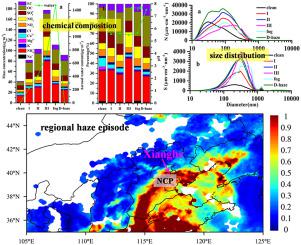当前位置:
X-MOL 学术
›
Atmos. Environ.
›
论文详情
Our official English website, www.x-mol.net, welcomes your
feedback! (Note: you will need to create a separate account there.)
Chemical composition, water content and size distribution of aerosols during different development stages of regional haze episodes over the North China Plain
Atmospheric Environment ( IF 4.2 ) Pub Date : 2021-01-01 , DOI: 10.1016/j.atmosenv.2020.118020 Lijuan Shen , Honglei Wang , Mengtian Cheng , Dongsheng Ji , Zirui Liu , Lili Wang , Wenkang Gao , Yuan Yang , Wei Huang , Renjian Zhang , Jianan Zou , Yuesi Wang
Atmospheric Environment ( IF 4.2 ) Pub Date : 2021-01-01 , DOI: 10.1016/j.atmosenv.2020.118020 Lijuan Shen , Honglei Wang , Mengtian Cheng , Dongsheng Ji , Zirui Liu , Lili Wang , Wenkang Gao , Yuan Yang , Wei Huang , Renjian Zhang , Jianan Zou , Yuesi Wang

|
Abstract Aerosol size distribution and chemical composition are found to have significant effects on its hygroscopicity, acidity/alkalinity and light extinction. Heavy haze pollution occurred frequently in the wintertime of NCP, with long duration time and large impact area, which had important influences on air quality and human health. However, the study concerning the formation mechanism and physicochemical characteristics of aerosols in different haze stages have been rarely carried out. In this study, aerosol size distribution in the range of 10 nm - 10 μm, water soluble inorganic ions (WSIIs), PM (PM2.5, PM10), trace gases, organic carbon (OC), elemental carbon (EC) and meteorological elements were derived during a regional haze pollution episode from Nov. 9 to 16, 2018. The aerosol water content and pH were further calculated using the ISORROPIA model. We divided the whole observation period into segments of clean days, fog processes, and haze processes, including three stages of I: accumulation, II: growth, and III: explosion, and a dry haze (D-haze) process based on the PM2.5 concentration, visibility and RH. Given the shift of particle size to larger segment ascribed to the ageing process during fog/haze process, the size distribution peak in aerosol number concentration was located at 100 nm in the fog/haze episode and was 70 nm larger than that on clean days. The concentration descended significantly in stage III, peaking at 160 nm, suggesting a strong aging process of aerosols. The PM2.5 increased sharply under high RH, static weather conditions and strengthening oxidation that favored liquid and heterogeneous reactions. The nitrate concentration was found to account for 20.5% (D-haze) - 29.0% (fog) of the total water soluble inorganic ions (WSIIs) during the fog/haze process, while sulfate constituted only 13.8% (stage III) - 21.3% (stage I), revealing dominant nitrate pollution. Hence, nitrate was considered to originate mainly from photochemical and heterogeneous reactions in haze episodes and was generated only by heterogeneous reactions. Higher (lower) aerosol water content made aerosols more acidic (alkaline) under similar chemical compositions. Therefore, the chemical reactions may differ under dry and wet haze pollution. Sources of carbonaceous aerosols changed in different haze stages with descending (enhancing) contributions from coal combustion (vehicle exhaust).
中文翻译:

华北平原区域性雾霾事件不同发展阶段气溶胶化学成分、含水量及粒径分布
摘要 发现气溶胶粒径分布和化学成分对其吸湿性、酸碱度和消光性有显着影响。新冠肺炎冬季重度雾霾污染频发,持续时间长,影响面积大,对空气质量和人体健康产生重要影响。然而,关于不同雾霾阶段气溶胶的形成机理和理化特性的研究却鲜有开展。本研究中,10 nm - 10 μm范围内的气溶胶粒径分布、水溶性无机离子(WSIIs)、PM(PM2.5、PM10)、微量气体、有机碳(OC)、元素碳(EC)和气象元素来源于 2018 年 11 月 9 日至 16 日的区域雾霾污染事件。使用 ISORROPIA 模型进一步计算了气溶胶水含量和 pH 值。我们将整个观测期分为清洁日、雾过程和雾霾过程三个阶段,包括三个阶段:I:积累,II:增长,III:爆炸,以及基于 PM2.5 的干霾(D-haze)过程。 .5 浓度、能见度和相对湿度。考虑到雾/霾过程中由于老化过程导致颗粒尺寸向更大段的转变,雾/霾事件中气溶胶数浓度的粒径分布峰值位于 100 nm 处,比清洁天大 70 nm。浓度在第三阶段显着下降,在 160 nm 处达到峰值,表明气溶胶的强烈老化过程。PM2.5在高RH下急剧上升,静态天气条件和加强氧化,有利于液体和非均相反应。发现在雾/雾过程中,硝酸盐浓度占总水溶性无机离子 (WSII) 的 20.5% (D-雾) - 29.0% (雾),而硫酸盐仅占 13.8% (阶段 III) - 21.3 %(阶段 I),揭示了主要的硝酸盐污染。因此,硝酸盐被认为主要来自雾霾事件中的光化学和非均相反应,并且仅由非均相反应产生。在相似的化学成分下,较高(较低)的气溶胶水含量使气溶胶的酸性(碱性)更高。因此,干湿雾霾污染下的化学反应可能不同。
更新日期:2021-01-01
中文翻译:

华北平原区域性雾霾事件不同发展阶段气溶胶化学成分、含水量及粒径分布
摘要 发现气溶胶粒径分布和化学成分对其吸湿性、酸碱度和消光性有显着影响。新冠肺炎冬季重度雾霾污染频发,持续时间长,影响面积大,对空气质量和人体健康产生重要影响。然而,关于不同雾霾阶段气溶胶的形成机理和理化特性的研究却鲜有开展。本研究中,10 nm - 10 μm范围内的气溶胶粒径分布、水溶性无机离子(WSIIs)、PM(PM2.5、PM10)、微量气体、有机碳(OC)、元素碳(EC)和气象元素来源于 2018 年 11 月 9 日至 16 日的区域雾霾污染事件。使用 ISORROPIA 模型进一步计算了气溶胶水含量和 pH 值。我们将整个观测期分为清洁日、雾过程和雾霾过程三个阶段,包括三个阶段:I:积累,II:增长,III:爆炸,以及基于 PM2.5 的干霾(D-haze)过程。 .5 浓度、能见度和相对湿度。考虑到雾/霾过程中由于老化过程导致颗粒尺寸向更大段的转变,雾/霾事件中气溶胶数浓度的粒径分布峰值位于 100 nm 处,比清洁天大 70 nm。浓度在第三阶段显着下降,在 160 nm 处达到峰值,表明气溶胶的强烈老化过程。PM2.5在高RH下急剧上升,静态天气条件和加强氧化,有利于液体和非均相反应。发现在雾/雾过程中,硝酸盐浓度占总水溶性无机离子 (WSII) 的 20.5% (D-雾) - 29.0% (雾),而硫酸盐仅占 13.8% (阶段 III) - 21.3 %(阶段 I),揭示了主要的硝酸盐污染。因此,硝酸盐被认为主要来自雾霾事件中的光化学和非均相反应,并且仅由非均相反应产生。在相似的化学成分下,较高(较低)的气溶胶水含量使气溶胶的酸性(碱性)更高。因此,干湿雾霾污染下的化学反应可能不同。











































 京公网安备 11010802027423号
京公网安备 11010802027423号